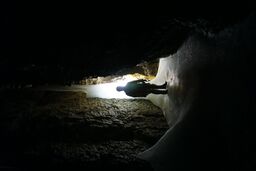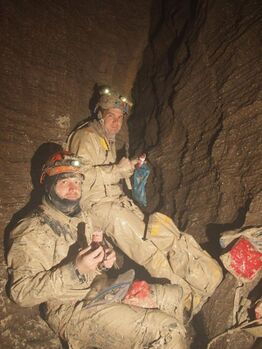Earth:Tears of the Turtle Cave
| Tears of the Turtle | |
|---|---|
 | |
| Location | Turtlehead Mountain, Bob Marshall Wilderness |
| Coordinates | [ ⚑ ] : 47°39′27″N 113°14′40″W / 47.65754°N 113.244448°W[1] |
| Depth | 2,052 feet (625 m)[2] |
| Length | 1.488 miles (2,395 m)[1] |
| Discovery | 2005[1] |
| Geology | karst |
| Entrances | 1 |
| Hazards | Temperature, Vertical, Remote Location |
Tears of the Turtle Cave is located in the Bob Marshall Wilderness in western Montana and is currently the deepest known limestone cave in the United States since passing New Mexico's Lechuguilla cave in 2014.[3] As of August 2022, the cave is known to be 2,052 feet (625 m) deep[2] and 1.488 miles (2,395 m) long.[1] The cave consists mostly of narrow fissure passages passing over approximately 50 short rope drops. With a mean temperature of 37 °F (3 °C) it is muddy and poorly decorated.[4]
Exploration History
The entrance to Tears of the Turtle Cave was found in 2006. The cave passage is mostly a two to three foot wide fissure that follows a stream downward through over 40 rappels. Initial single-day expeditions of the cave reached a depth of 400 feet. In 2014, a team of nine cavers underwent the first multi-day expedition and explored a new passage pushing the cave to a depth of 1629 feet, surpassing New Mexico's Lechuguilla Cave to become the deepest known limestone cave in the United States.[3][5][6] Exploration continued in 2016 when teams descended to a depth of 1659 feet.[7] A 2019 expedition extended the known depth of the cave to 1,863.8 feet (568.1 m).[1], and in 2022 the cave was explored further to a depth of 2,052 feet (625 m).[2]
The depth of the cave, along with the technical rope work required to reach that depth, 37 °F (3 °C) temperature, and remote location of the cave make continued exploration difficult. Ongoing exploration is done through the Caves of Montana Project, an official project of the National Speleological Society. Exploration is conducted under a MOU with the United States Forest Service.
Geology
The cave is located in typical karst landscape and is formed in the Cambrian Pagoda Limestone. Over the years water from rainfall and snowmelt have dissolved away the limestone to form a typical vadose solutional cave with fissure passage 2–3 feet wide and tall ceilings.[8]
See also
References
- ↑ 1.0 1.1 1.2 1.3 1.4 (in en) Back in Tears: The 2019 Expedition to America's Deepest Cave, https://www.youtube.com/watch?v=YsehRxVuksM, retrieved 2021-04-26
- ↑ 2.0 2.1 2.2 Ballensky, Jason (6 August 2022). "Facebook post by Jason Ballensky". https://www.facebook.com/jasonballensky/posts/pfbid0Epp36mZjndhxQRTwYsTp3LBRdUrRDHsTrgxmSdfNsZxMVcvbY5XdgvYFBg6PwKygl.
- ↑ 3.0 3.1 McDermott, Ted. "Deepest cave discovered in the Bob". Missoula News. http://missoulanews.bigskypress.com/IndyBlog/archives/2014/09/02/deepest-cave-discovered-in-the-bob.
- ↑ Johnson, Peter (2014). "Tears in Montana: Deep Caving in the Bob Marshall Wilderness". NSS News 72, #12: 6.
- ↑ "Exploring the Hidden World of The Bob". 2014-09-17. http://flatheadbeacon.com/2014/09/17/exploring-hidden-world-bob/.
- ↑ "The Bob has a deep, dark wilderness secret". Spokesman.com. http://www.spokesman.com/blogs/outdoors/2014/sep/05/bob-has-deep-dark-wilderness-secret/.
- ↑ "How Low Can They Go?". Montana Outdoors. https://fwp.mt.gov/binaries/content/assets/fwp/montana-outdoors/2016/caving.pdf.
- ↑ Bodenheimer and Powell, Hans and John (2012). "Continental Divide Syncline Geology". Alpine Karst 4. http://alpinekarst.org/vol4-2012/.
External links
 |



